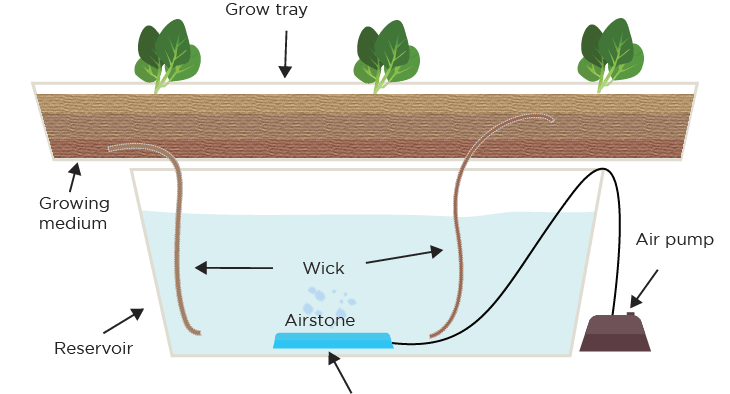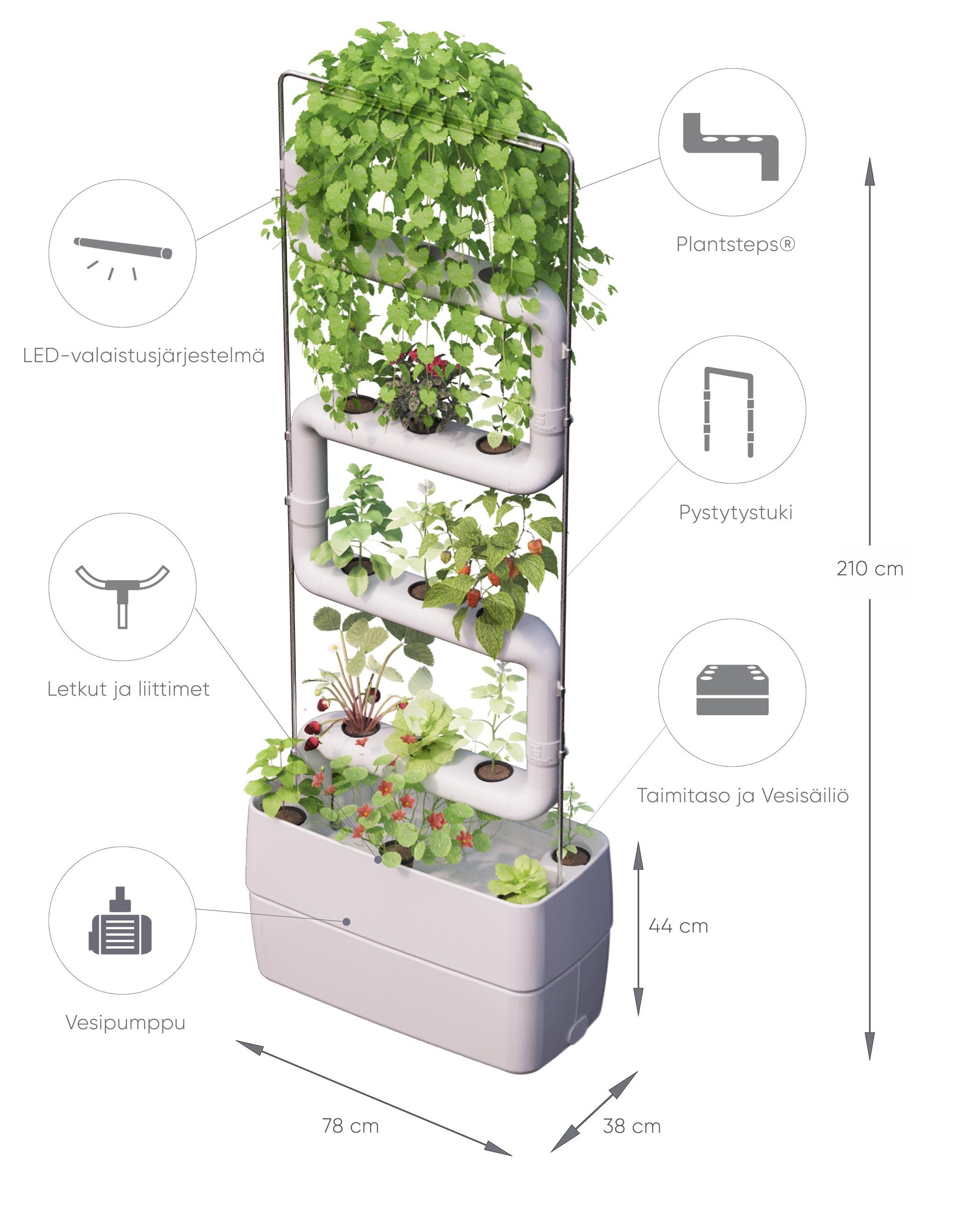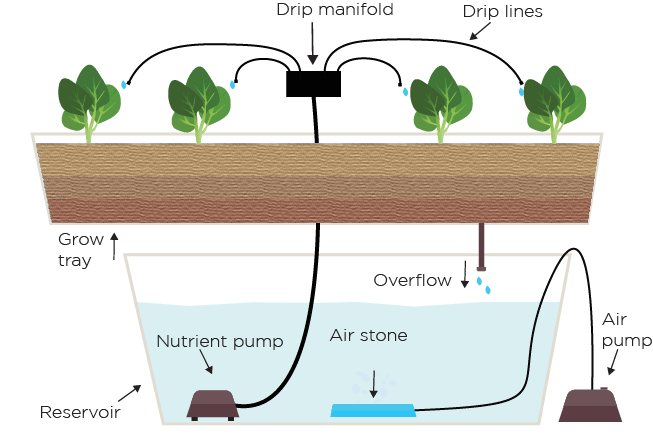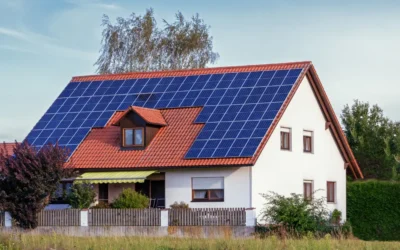A hydroponic garden works by growing plants without soil, using a nutrient-rich water solution instead. It is a soilless method of gardening that relies on water, nutrients, and a growing medium to provide plants with necessary elements for growth.
Hydroponic systems can be set up in various ways, such as using nutrient film technique (NFT), deep water culture (DWC), or aeroponics, providing a controlled environment for plants to flourish. The benefits of hydroponic gardening include faster growth, higher yields, and the ability to grow plants in limited spaces.
Additionally, it offers precise control over the growing conditions, ensuring optimal nutrient uptake for plants. We will explore the inner workings of a hydroponic garden and understand how it provides an innovative solution to modern agriculture.

Credit: www.trees.com
Advantages Of Hydroponic Gardening
Experience the numerous advantages of hydroponic gardening, a method that allows plants to grow without soil. By providing essential nutrients directly to the plants’ roots, hydroponic gardens conserve water, maximize space, and yield higher crop production compared to traditional gardening methods.
Higher Yield
Hydroponic gardening offers a higher yield compared to traditional soil-based gardening. This method allows plants to receive a precisely balanced supply of nutrients, water, and oxygen directly to their root systems. By eliminating the need for plants to search for nutrients in the soil, their energy can be redirected towards faster growth and increased productivity. As a result, hydroponic gardens often produce larger and healthier crops than traditional gardens.
Water Efficiency
One of the noteworthy advantages of hydroponic gardening is its significant water efficiency. Traditional soil-based gardens can lose a significant amount of water through evaporation, runoff, or absorption by surrounding plants. In hydroponics, water is recirculated through the system, minimizing waste by reusing irrigation and nutrient solutions. This water-saving feature not only reduces the overall water consumption but also makes hydroponics an environmentally friendly option for gardening.
Year-round Growing
Hydroponic gardening offers the advantage of year-round plant cultivation. Unlike traditional gardening that is limited by seasonal changes and weather conditions, hydroponics provides controlled environments where elements like temperature, lighting, and humidity can be adjusted to suit the needs of the plants. With the ability to recreate optimal growing conditions, hydroponic gardeners can enjoy fresh produce regardless of the time of year, fulfilling their love for gardening even during harsh winters or dry summers.
No Soil Contamination
Another advantage of hydroponic gardening is the absence of soil contamination. In traditional gardening, plants can be exposed to soil-borne diseases, pesticides, or heavy metals present in the soil. With hydroponics, plants grow in a soil-free medium, reducing the risk of contamination and ensuring a cleaner and safer harvest. This makes hydroponic garden produce an ideal choice for health-conscious individuals or those concerned about the quality and safety of their food.

Credit: www.supragarden.com
How Does A Hydroponic Garden Work?
A hydroponic garden is a modern and efficient way of growing plants without the use of soil. This innovative gardening method relies on a nutrient-rich water solution to supply essential minerals directly to the plant roots, resulting in faster growth and higher yields. Let’s explore the key components that make a hydroponic garden work.
Nutrient Solution
The nutrient solution is a carefully balanced mixture of essential minerals and nutrients, such as nitrogen, potassium, and phosphorus, dissolved in water. It provides the necessary elements for plant growth, enabling them to thrive without soil. The solution is circulated to the plant roots, ensuring they receive the required nutrients for healthy development.
Root Support
In a hydroponic system, plants are supported by various root structures, such as Rockwool cubes, vermiculite, or perlite. These substrates offer stability and aeration for the roots, allowing them to access the nutrient solution while providing adequate support for the plant’s structure.
Water Circulation
Water circulation is a critical aspect of hydroponic gardening. Through a pump or a recirculating system, the nutrient solution is continuously circulated throughout the system, ensuring that the plant roots receive a constant supply of essential nutrients while preventing stagnation and maintaining oxygen levels for healthy root development.
Lighting
Proper lighting is essential for hydroponic gardens, as it serves as an alternative to natural sunlight. LED or fluorescent grow lights are commonly used to provide the necessary spectrum of light for photosynthesis, enabling plants to flourish and thrive in an indoor environment.
Temperature And Humidity Control
Maintaining an optimal temperature and humidity level is crucial for the success of a hydroponic garden. By regulating the environment, plants can thrive in ideal conditions, promoting healthy growth and minimizing the risk of pests and diseases.
Popular Hydroponic Systems
Hydroponic gardening is gaining popularity due to its efficiency and ability to produce high-quality crops with minimal resources. There are several hydroponic systems available, each offering unique advantages. Let’s explore the most popular hydroponic systems:
Deep Water Culture (dwc)
Deep Water Culture is a simple and widely-used hydroponic system. In DWC, the plant roots are suspended in nutrient-rich water, ensuring constant access to essential nutrients. This system is particularly effective for growing leafy greens and herbs. It involves using a floating platform or net pots to support the plants while an air stone aerates the water, providing oxygen to the roots. DWC is an ideal choice for beginners as it requires minimal maintenance and investment.
Drip System
The Drip System is a popular choice for larger-scale hydroponic setups. This system delivers nutrient-rich water directly to the plant’s roots using a dripper system or emitters. It is commonly used for growing tomatoes, peppers, and other fruiting plants. The nutrient solution is provided in a constant drip or timed intervals, ensuring the plants receive a consistent supply of water and nutrients. Drip systems offer precise control over nutrient delivery, making it easier to adjust and optimize nutrient levels according to plant requirements.
Nutrient Film Technique (nft)
Nutrient Film Technique is a hydroponic system that utilizes a thin nutrient film flowing over a growth channel. This system is ideal for growing small, fast-growing plants like lettuces and herbs. In NFT, a sloping channel allows a thin layer of nutrient solution to flow continuously, bathing the roots while providing them with nutrients. The excess nutrient solution is collected and recirculated, conserving water and nutrients. NFT systems offer excellent aeration to roots, promoting healthy growth and faster plant development.
Aeroponics
Aeroponics is an advanced hydroponic system that requires minimal growing media. It is suitable for growing a wide range of plants, including vegetables, herbs, and even certain fruit trees. In Aeroponics, plant roots are suspended in air, misted with a nutrient solution at regular intervals. This misting system provides a highly oxygenated environment for roots, promoting rapid growth and nutrient absorption. Aeroponics is known for its efficient use of resources, making it a preferred choice for commercial growers.

Credit: www.trees.com
Conclusion
In short, hydroponic gardening offers a sustainable and efficient way to grow plants without soil. It provides complete control over the environment, resulting in healthier, more abundant yields. By understanding the basic principles and techniques involved, you can easily set up a hydroponic garden at home.
With minimal maintenance and maximum productivity, it’s a valuable option for any gardening enthusiast.








